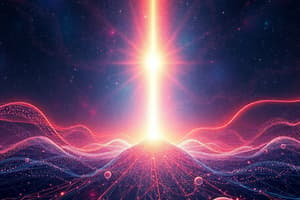Podcast
Questions and Answers
What is the approximate speed of light in a vacuum?
What is the approximate speed of light in a vacuum?
- 250,000 kilometers per second
- 299,792 kilometers per second (correct)
- 150,000 kilometers per second
- 300,000 kilometers per second
Which of the following describes the reflection of light?
Which of the following describes the reflection of light?
- Angle of incidence equals angle of reflection (correct)
- Light is scattered in multiple directions upon hitting a surface
- Light bends as it passes from one medium to another
- Light changes color when absorbed by surfaces
What happens to light when it enters a different medium?
What happens to light when it enters a different medium?
- It travels at the same speed
- It is always reflected back
- It changes direction and speed (correct)
- It disappears completely
Which colors are considered primary colors of light?
Which colors are considered primary colors of light?
What physical phenomenon contributes to the formation of a rainbow?
What physical phenomenon contributes to the formation of a rainbow?
How is light generally described in physics?
How is light generally described in physics?
What is the effect of a lens on light?
What is the effect of a lens on light?
Which of the following best defines visible light?
Which of the following best defines visible light?
Flashcards are hidden until you start studying
Study Notes
الفزياء: الضوء
-
تعريف الضوء:
- الضوء هو شكل من أشكال الطاقة، يُعتبر جزءًا من الطيف الكهرومغناطيسي.
- يمكن رؤيته بواسطة العين البشرية، ويُسمى الضوء المرئي.
-
خصائص الضوء:
- السرعة:
- يُعتبر الضوء أسرع شيء في الكون، حيث يسير بسرعة حوالي 299,792 كيلومتر في الثانية في الفراغ.
- الانعكاس:
- عندما يصطدم الضوء بسطح، يمكن أن ينعكس عنه، ويُستخدم قانون الانعكاس (زاوية السقوط = زاوية الانعكاس).
- الانكسار:
- يحدث عندما ينتقل الضوء من وسط إلى آخر، مما يؤدي إلى تغيّر سرعته واتجاهه.
- يُستخدم قانون سنيل لوصف العلاقة بين زوايا السقوط والانكسار.
- السرعة:
-
الطيف الكهرومغناطيسي:
- يتضمن عدة أنواع من الإشعاعات، مثل الأشعة تحت الحمراء، الضوء المرئي، والأشعة فوق البنفسجية.
- الضوء المرئي هو الجزء الضيق من الطيف الذي يمكن رؤيته.
-
اللون:
- يُنتج اللون من تفاعل الضوء مع المواد، حيث ينعكس بعض الأطوال الموجية ويُمتص البعض الآخر.
- الألوان الأساسية هي الأحمر، الأزرق، والأصفر.
-
الموجات الضوئية:
- الضوء يُعتبر موجة كهرومغناطيسية، حيث يمكن وصفه كدالة موجية.
- طول الموجة: يُشير إلى المسافة بين قمتين متتاليتين، يؤثر على اللون.
-
التطبيقات:
- العدسات: تُستخدم لتركيز الضوء وتوجيهه، مثل العدسات في النظارات والكاميرات.
- الألياف البصرية: تُستخدم لنقل المعلومات من خلال الضوء.
-
ظواهر ضوئية:
- قوس قزح: يحدث نتيجة الانكسار والانعكاس في قطرات الماء، مما يؤدي إلى تفكيك الضوء إلى ألوانه المختلفة.
- الظلال: تُنتج نتيجة حجب الضوء بواسطة جسم ما.
-
الفيزياء الحديثة:
- نظرية الكم: تُعتبر الضوء أيضًا جزيئات تُسمى الفوتونات، التي لها خصائص الموجات والجسيمات.
Definition of Light
- Light is a form of energy and part of the electromagnetic spectrum.
- Visible light refers specifically to the portion of the spectrum that can be seen by the human eye.
Properties of Light
-
Speed:
- Light travels at approximately 299,792 kilometers per second in a vacuum, making it the fastest entity in the universe.
-
Reflection:
- When light strikes a surface, it can bounce back, described by the law of reflection (angle of incidence = angle of reflection).
-
Refraction:
- Refraction occurs when light moves between different media, changing its speed and direction, governed by Snell's Law which relates the angles of incidence and refraction.
Electromagnetic Spectrum
- The spectrum includes various types of radiation such as infrared, visible light, and ultraviolet.
- Visible light is a narrow segment of the spectrum detectable by the human eye.
Color
- Colors result from the interaction between light and materials, reflecting certain wavelengths while absorbing others.
- Primary colors of light are red, blue, and yellow.
Wave Properties
- Light is classified as an electromagnetic wave, often described as a wave function.
- Wavelength: The distance between successive peaks of the wave affects the perceived color.
Applications of Light
- Lenses: Used to focus and direct light, found in glasses and cameras.
- Optical Fibers: Transmit information using light for communication.
Optical Phenomena
- Rainbow: Formed by refraction and reflection of light in water droplets, dispersing light into its constituent colors.
- Shadows: Created when an object blocks light from reaching a surface.
Modern Physics
- Quantum Theory: Proposes that light also exists as particles called photons, which exhibit both wave-like and particle-like properties.
Studying That Suits You
Use AI to generate personalized quizzes and flashcards to suit your learning preferences.




